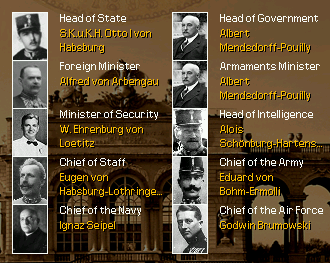Austria
From Kaiserreich
m |
m |
||
| Line 13: | Line 13: | ||
| align=center style="background:#f9f9f9;" font-size:95% colspan=2 | '''Motto'''<br>''A.E.I.O.U.'' | | align=center style="background:#f9f9f9;" font-size:95% colspan=2 | '''Motto'''<br>''A.E.I.O.U.'' | ||
|- | |- | ||
| - | | align=center font-size:95% colspan=2 | '''Anthem''' <br> Gott erhalte Franz den Kaiser | + | | align=center font-size:95% colspan=2 | '''Anthem''' <br> [[Gott erhalte Franz den Kaiser]] |
|- | |- | ||
| align=center colspan=2 | http://i231.photobucket.com/albums/ee48/Cornichouille/Kaiserpedia/Austria-MAP-1.png | | align=center colspan=2 | http://i231.photobucket.com/albums/ee48/Cornichouille/Kaiserpedia/Austria-MAP-1.png | ||
Revision as of 10:18, 29 December 2008
| ||||
| Motto A.E.I.O.U. | ||||
| Anthem Gott erhalte Franz den Kaiser | ||||

| ||||
|
| ||||
| Official Languages | German, Hungarian, Romanian, Czech, Slovak, Slovene, Croatian, Serbian, Italian, Polish, Ruthenian | |||
| Capital | Vienna | |||
| Head of State | Otto I von Habsburg | |||
| Head of Government | Albert von Mensdorff-Pouilly-Dietrichstein | |||
| Establishment - Proclaimation of the Austrian Empire | 1804 | |||
| 1867 Augsleich | May 29, 1867 | |||
| Government | Parliamentary monarchy, full constituent state of Austria-Hungary | |||
| Currency | Austro-Hungarian krone | |||
| Area | 123 725 km² | |||
| Population | About 12 millions | |||
Austria is a primary constituent of the Austro-Hungarian dual monarchy. It borders Germany in the north, Italian Federation in the south and Switzerland in the east. Within the dual monarchy, the areas of Bohemia, Hungary and Croatia also border Austria.
Contents |
History
Although Austria was on the winning side of the Weltkrieg, the war’s main impact was to reveal the Empire’s significant weaknesses and utter dependence upon Germany. Over the course of the 1920s one disaster followed another: the Emperor Karl died in 1922 causing the throne to pass to his 10 year old son Otto; Austrian industry collapsed in face of competition from German manufactures; and the quarrels of the Czechs and ethnic Germans in Bohemia nearly pushed the Empire into civil war. Finally, the humiliation of having to call in German mediation to resolve the deadlock of the Ausgleich negotitions in 1927, which resulted in the concession of autonomy statutes given to Bohemia and Galicia, seemed to signal the end of Austria as a Great Power.
However, many feel that there is new hope for the Osterreich - now that the Emperor Otto I has come of age and the terms of the ‘Great Compromise’ are to be renegotiated at the 1937 Ausgleich next year. Could this be the time for Austria to throw off her shackles of dependence on Germany and reassert the power of the Habsburg dynasty over her Empire?
Politics
|
Emperor of Austria: His Imperial Highness Otto I von Habsburg (born 20 November 1912)
Minister-President and Minister for Finance Albert von Mensdorff-Pouilly-Dietrichstein (born 5 September 1861)
Minister for Foreign Affairs: Alfred Rappaport von Arbengau (born 16 June 1868)
Minister of the Interior: W. Ehrenburg von Loetitz
Director of the Imperial Military Intelligence: Alois Schönburg-Hartenstein (born 21 November 1858)
Chief of General Staff of the Imperial and Royal Army: Eugen von Habsburg-Lothringen (born 21 May 1863)
Commander-in-Chief of the Austrian Landwehr: Eduard von Böhm-Ermolli (born 12 February 1856)
Commander-in-Chief of the Austrian branch of the Kaiserliche und Königliche Kriegsmarine : Ignaz Seipel (born 19 July 1876)
Commander-in-Chief of the Austrian branch of the Kaiserliche und Königliche Luftfahrtruppen: Godwin Brumowski (born 26 July 1889)



